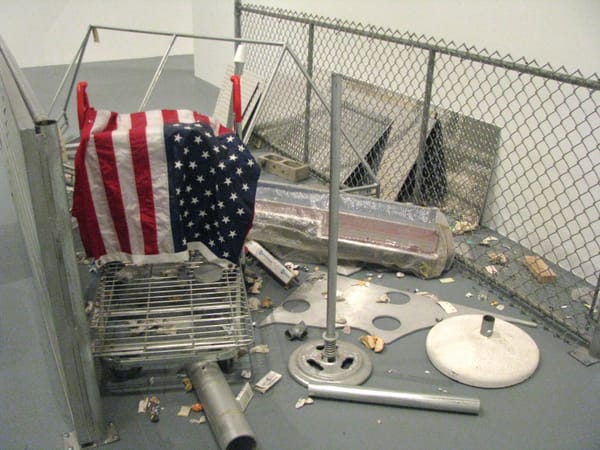Cady Noland’s art, appropriated images silk-screened onto sculptural objects and installations of assorted found objects, celebrates the idea of America—its dream and promise—and indicts the way this ideal has been perverted in pursuit of the almighty dollar. So when I learned that Gagosian’s Upper East Side gallery would host Noland’s first exhibition of new work since she “retired” from the art world in 1999, I was excited. But I also worried about Noland’s ability to hold true to her thematic content in an art world that now dismisses America as white supremacist and illegitimate.
Since Noland’s show debuted, I have heard people call it Noland’s first “libtard spazz out” or dismiss it as more bourgeois liberal fetishization of the American poor. I don’t agree with either of these sentiments, but I’m more sympathetic to the latter. Where I diverge from this critique is I don’t really see urban liberal bourgeois fetishism of Americana to be such a negative thing. Noland is, after all, a wealthy Manhattanite with little authentic exposure to the middle of the country. Not entirely unrelated, the late Dash Snow—another rich Manhattanite artist with an interest in the mythology of America—remarked once that New York only felt like it was a part of “America” after 9/11. Prior to that, he claimed, Manhattan felt like a different country—more European than American.
“Noland ... has an outsider’s fascination with America.”
Noland, then, has an outsider’s fascination with America. Many critics’ problems with Diane Arbus as a photographer are similar: “What does this rich woman have to do with these poor, lonely freaks that she captures so beautifully in her photography?” Nothing. Her gaze was purely fetishistic, even negatively erotic. Arbus was luridly fascinated with those sad, morbid little creatures, and her images are obviously perverse. Why can’t an artist be fascinated with worlds beyond her own? Such fetishistic indulgence is the divine right of the artist.
Noland’s work allows us to view America in a new light. Jean Baudrillard wrote, “America is the original version of modernity…. Having lived no primitive accumulation of time, it lives in a perpetual present.” New York, on the other hand, lives between its widely historicized past and its ever-looming and increasingly bleak future. It moves forward and looks backward and never pauses to perceive the now. America’s “nowness” becomes Noland’s access point to the contemporary.
Noland sometimes refers to a concept she calls “the game.” The central contradiction her installations attempt to render is that between the American ideal—freedom, prosperity, forward momentum—and “the game,” which manipulates us into thinking that the American Dream is still thriving, when, in fact, it’s been dead for a long time. One example Noland uses is of the tabloid media, which she says use sensationalistic and often partly concealed images to satisfy the public, while ultimately obscuring the full truth from them.
Noland’s most iconic interpretation of “the game” is found in her aluminum sculptural blow-ups of iconic tabloid images. “Oozewald,” from 1990, for example, depicts Lee Harvey Oswald at the moment when he was killed by Jack Ruby. The piece is a straightforward appropriation of the image, except for one detail—it is covered in holes. Looking at it, you access the contradictory meaning that Oswald took on in American society. We wanted him dead, because he killed our president. But that isn’t the whole story—there are holes in this interpretation. Thus Noland evokes the intelligence connections around Oswald that the tabloid sensationalist headline—“JFK Killer Shot Dead!”—would obscure.
In her new exhibition at Gagosian, it seems that Noland’s fetishism of Americana has taken on a darker undercurrent. Mercifully, Noland still refuses to editorialize: no news release, no textual guide. Your interpretation is yours to have. The exhibition features Budweiser and Coke cans, grenades, crutches, shotgun shells, odd silver figurines in the form of George Washington or pillars with horse heads, and otherwise. Many of the objects are encased in rectangular glass prisms. What this is supposed to signify I can only speculate. Perhaps a general indictment of corporate cynicism and consumerist society? Drink too much Coke, get diabetes, and end up on crutches. If so, it isn’t an altogether prescient insight, but it isn’t necessarily wrong.
If anything, I regret Noland’s failure to make any reference to America’s pharmaceutical industry—the purest embodiment of selling you the sickness and the cure in one fell swoop. Such imagery would surely heighten the potency of the exhibition’s subtext. This dark aspect of America is left unacknowledged, and it feels like another one of the “holes” in Noland’s own thinking.
Formally, Noland hasn’t lost her touch. The works are rigorously laid out with a clear logic, even as they veer closer to chaos. The chaotic element, however, is intriguingly dialed down. Perhaps those glass prisms, then, represent the ways in which the American Dream has been put under the microscope—through the looking glass, if you will—by a surveillance apparatus.
Indeed, I couldn’t help but think of the way that at every level, even in its myriad pleasures, the American ideal has absorbed a dark undercurrent of malignant, bureaucratic voyeurism. In his book The Transparency Society, Byung-Chul Han says that “the end of politics is the end of secrecy.” Perhaps that is what Noland mourns. Perhaps her return to the art world is but a funeral for the forward momentum into the future that once defined the American Dream.
